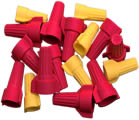Replace a Recessed Light Fixture with Recessed Can Lights
Considering replacing that old fluorescent fixture in your kitchen with recessed can lights? Maybe you’re interested in a new look for your cooking area or perhaps you’d prefer your illumination source create a different ambience throughout your kitchen? In this article, we’ll consider the basic steps involved in this process and look at some fixture options, including fixture size, voltage, style and trim choices. Plus, this will work for updating lighting in any room.
 |
Caution: Please read our safety information before attempting any testing or repairs.
Electrical work requires safe practices. Always turn off power at the circuit breaker or fuse box. Post a note that work is being done, to avoid someone turning the power back on. After turning off the power to the circuit, test the circuit to be certain that there is no power. Always use insulated tools for added safety. Check with your local building department for regulations and permit requirements before beginning work.
Basic Steps:
This is an overview of the replacement process, which is detailed in other articles. For our purposes, we’ll assume that the fluorescent fixture is 3 feet by 4 feet (although it may be any size) and that once removed there will be an opening approximately one-foot deep.
- Remove the fluorescent fixture. Tools will most likely include a screwdriver, electrician’s pliers and wire cutters. In order to comfortably perform this job, you’ll also require a ladder.
- In order to install the round recessed fixtures into the rectangular opening, you’ll need to create a ceiling patch using dry wall.
- To install the new fixtures, you’ll cut appropriately sized openings into the uninstalled patch.
- The new fixtures can be connected to the same electrical line that the fluorescent fixture used. You’ll connect the closest light to your primary power line and then connect one light to another in succession.
- Depending on the type of fixtures you choose and the kind of patch you make, mounting brackets may be incorporated, or the can lights may be able to float in the ceiling, secured by the trim.
- Once the fixtures are secured, you may measure the openings for the fixture and cut them from the patch. You can then mount the dry wall patch.
- Once everything is secure, the trim may be added.
Recessed Can Lights
Recessed can lights come in two specific styles and a variety of sizes and trims. The two styles of fixtures are eyeball light and down light. Eyeballs are directional with part of the can protruding from the opening while the trim fits flush to the ceiling. Eyeballs can rotate and swivel, allowing you to change the direction of the beam of light. Down light recessed fixtures are stationary, with the beam of light being projected directly downward.
 |
Diameter sizes start at 2 inches and go up to 6 inches, with low voltage fixtures usually having either 2, 3 or 4-inch diameters. Line voltage lights are available in diameters of 4, 5 and 6 inches.
Trims, which come in a variety of colors and styles, range in size from 2.5 inches to 8 inches. The most common colors for trims are black, white, gold copper, chrome and natural metal. Some trims are adjustable, with styles including baffle, glass, pinhole, reflector and wall wash.
There are also various types of lenses that can be used in many lights. These lenses, which are optional, will spread light differently within a given area, with some diffusing it and others creating more direct beans. Frosted lenses soften the beam, while spread lenses allow light to be disseminated in all directions. Linear spread lenses extend light in one direction. Honeycomb louvers create a stylized look and are most often used on smaller instruments. Lenses are held on with clip on holder.
You’ll also be able to choose between low voltage and line voltage models. Line voltage in the United States is 120 volts; when you use line voltage instruments they simply run on this standard voltage. Smaller recessed fixtures operate on a lower voltage. Low voltage fixtures come with a transformer that reduces the 120 volts to an acceptable level so that the light can function. Line voltage fixtures are usually less expensive to purchase, while low voltage lights offer brighter and more dramatic results, emit less heat and are cheaper to operate. However these instruments, because of their intensity, can create more glare off of shiny counter surfaces.
Before deciding between low and line voltage recessed fixtures, consider where the light will be focused and its purpose. Artistically, low voltage instruments are superior, while line voltage lights provide a softer light that is good for working around the kitchen and reading.
Recessed can fixtures will give your kitchen a new look, providing illumination from specific areas that can either be spread across a surface or directly focused on one spot. Because of the various styles and choices, instruments can be specifically chosen according to their function and for their form. They offer a way for you to give your kitchen a new look and feel.





